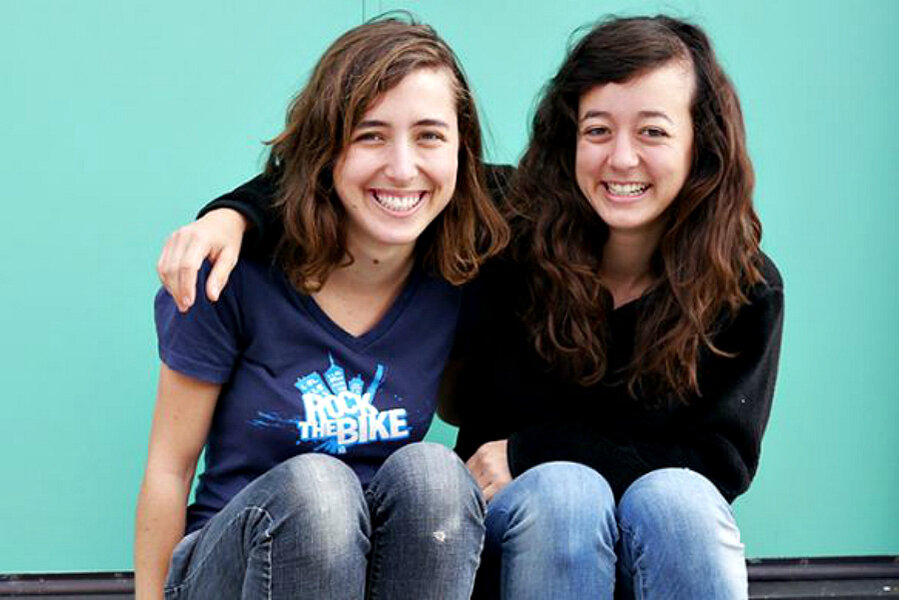Biking across America to teach pop-up science classes
Loading...
Forget about the Tour de France—for Elizabeth Case and Rachel Woods-Robinson, it’s time for Tour de U.S.A.
On April 17, the two UCLA alums will embark on an eco-friendly cross-country road trip, pedaling their bicycles over 3,800 miles from San Francisco to New York City. Along the way, they’ll make pit stops to teach middle school students quick lessons in physics, solar power, and renewable energy.
“The whole thing is a little terrifying, to be completely honest,” said Case, who met Woods-Robinson while studying abroad in Europe. “But we’ll get on our bicycles, we’ll pedal every day, and we will make it across the country somehow.”
Full of wanderlust but also passionate about the world of science, the duo wanted to turn their adventure into something that others could benefit from as well. Thus, Cycle for Science was born.
“Science is what explains our world, and it is our hope that every kid has a chance to understand that,” Case said. “Everyone, but especially girls.”
In 2012, only 33.5 percent of female college freshmen intended to pursue science and engineering degrees. And in 2011, the Economics and Statistics Administration reported that women hold less than 25 percent of science, technology, engineering, and math (STEM) jobs in the United States.
Case said she didn’t realize her passion for physics and engineering until part way through her years at UCLA. Originally an English major and intending to pursue a career in journalism, she ended up switching to physics instead—the same subject that Woods-Robinson studied.
“Girls in middle school and high school don’t necessarily have a role model in these fields. That makes it more difficult to visualize themselves as successful female scientists,” Case said.
Because kids seem to think that scientists are men in white lab coats with frizzy, unkempt hair, Case thinks there is a great opportunity to have an open conversation about women and the role—or lack thereof—that they play in the sciences.
“But it is even more than that,” Case said. “It’s also a chance to encourage people to take a moment and just teach a little science. Like if there’s a kid playing in the mud, say, ‘Hey, let’s take a closer look at the mud. Look, there are microbes in it. What else do you observe here?’ ”
On their cross-country journey, Case and Woods-Robinson plan to conduct lessons in a kid-friendly way by using the Sol Cycle, a miniature, 3-D printable bicycle model they designed and created themselves.
They will also interview teachers at each of the schools they visit.
“It’s easy for us to talk about the need for hands-on learning, but these teachers have almost no budgets for labs,” Case said. “We have ideas, stereotypes. and assumptions, and we’ve read studies. But they have such grit, dedication, and passion. We want to know what they find difficult, rewarding, and successful.”
Having raised enough money for the bike trip but not for the educational portion of the endeavor, the two launched a fund-raising campaign to help offset the cost of building the models.
The Cycle for Science IndieGoGo campaign kicked off on Feb. 17 and raised $1,041 within the first 48 hours—well on the way to their $6,000 goal. The money will go toward building materials for the Sol Cycle models, video equipment for teacher interviews, and extra travel costs due to the extra days allotted for teaching.
Case said the outpouring of generosity and support they’ve gotten so far is astonishing. “We could not have predicted it. It’s remarkable to think that that people see something like this and feel as strongly as Rachel and I do about it.”
“I think there are these questions we can ask in the world, and encourage kids to ask them too. That’s what will produce the next generation of scientists,” Case said. “I mean, you don’t have to become a scientist. But no matter what you do, it’s good to wonder.”
• Ashley Jakubczyk is a graduate student at Harvard University. She has also written for Thought Catalog,The Daily Bruin,The Daily Breeze, and Peninsula People magazine.
• This article originally appeared at TakePart, a leading source of socially relevant news, features, opinion, entertainment, and information – all focused on the issues that shape our lives. Visit takepart.com/start-from-the-source.
Related stories on TakePart
Here's How Car Makers Are Trying to Make Streets Safer for Bicycle CommutersFor the Love of Money: France Is Paying People to Bike to WorkWith This Pedal-Powered Generator, Biking Gives Light to Kids Living Without Electricity







